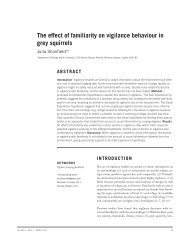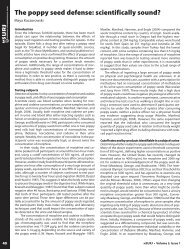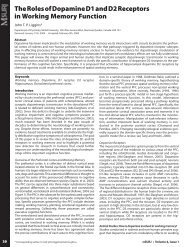the entire issue - McGill Science Undergraduate Research Journal ...
the entire issue - McGill Science Undergraduate Research Journal ...
the entire issue - McGill Science Undergraduate Research Journal ...
Create successful ePaper yourself
Turn your PDF publications into a flip-book with our unique Google optimized e-Paper software.
Proof-carrying authorization in distributed systems with Beluga: a case study<br />
Systems which utilize proof-carrying authorization are both easier to<br />
implement and more efficient. In systems that don’t use proof-carrying<br />
authorization, <strong>the</strong> verifier must decide whe<strong>the</strong>r or not to grant<br />
access to a requester. Programming such communications is difficult<br />
and time-consuming. However, in <strong>the</strong> method of proof-carry authorization,<br />
<strong>the</strong> requester can simply supply in its proof <strong>the</strong> reason why<br />
it should be granted access. Thus <strong>the</strong> method of proof-carrying authorization<br />
is faster and more straight-forward. While authorization<br />
of a proof in systems which use proof-carrying authorization takes<br />
time which is linear in <strong>the</strong> size of <strong>the</strong> proof, <strong>the</strong> verification or denial<br />
of access of a machine is much more time-consuming (6).<br />
How to represent proofs<br />
In order to make use of <strong>the</strong> method of proof-carrying authorization,<br />
it is imperative to be able to have a language which can represent<br />
proofs and policies. Proofs need to be represented as some sort of<br />
digital certificate. But in order for clients and servers to write and<br />
interpret proofs correctly, <strong>the</strong> language system must be unambiguous<br />
and must be easily dissected and understood by all <strong>the</strong> machines.<br />
This is difficult due to <strong>the</strong> complexity of most policies. Each distributed<br />
system has its own policy, and within a system, each set of data<br />
could have its own policy.<br />
The problem of creating a language with which to encode <strong>the</strong> policy<br />
is discussed in <strong>the</strong> next section. Once this language is established<br />
however, implementing <strong>the</strong> language in a way that is understandable<br />
to a computer follows from converting each rule of <strong>the</strong> policy<br />
into an inference rule and representing proofs rigorously as a logical<br />
inference (6).<br />
PCML 5<br />
The growing popularity of distributed systems in <strong>the</strong> form of webbased<br />
services motivates <strong>the</strong> creation of a language in which policies<br />
can be encoded and distributed programs can be expressed (9).<br />
Avijit, Datta and Harper introduced a programming language, PCML 5<br />
,<br />
in <strong>the</strong>ir paper entitled Distributed Programming With Distributed Authorization<br />
(9). PCML 5<br />
is intended to simplify <strong>the</strong> programming of proofs<br />
for security in a distributed system with distributed authorization. It<br />
achieves this through its support for distributed computations, <strong>the</strong><br />
implementation of an authorization logic, and <strong>the</strong> ability to represent<br />
both policies and proofs (9).<br />
An authorization logic is a formal system of logic which supports<br />
<strong>the</strong> encoding of policies as <strong>the</strong>ories. PCML 5<br />
encodes an authorization<br />
logic by integrating <strong>the</strong> framework of <strong>the</strong> logic directly into PCML 5<br />
’s<br />
type system. For example, we can use an authorization logic to prove<br />
progress and preservation. The proof of progress states that if m is an<br />
expression, <strong>the</strong>n ei<strong>the</strong>r m is a value or m steps to some o<strong>the</strong>r expression<br />
m′. The proof of preservation states that if m is of type T and m<br />
steps to m′ <strong>the</strong>n m′ is of type T. Toge<strong>the</strong>r, progress and preservation<br />
ensure type safety.<br />
Why implement PCML 5<br />
in Beluga?<br />
The successful implementation of PCML 5<br />
in Beluga provides formal<br />
guarantees about PCML 5<br />
itself. Specifically, we can gain insight into<br />
<strong>the</strong> <strong>the</strong>orems such as progress and preservation which toge<strong>the</strong>r ensure<br />
type safety of <strong>the</strong> language. This case study will also aide in <strong>the</strong><br />
understanding of both <strong>the</strong> development and implementation of software<br />
systems and programming with proofs. Implementing PCML 5<br />
in<br />
Beluga raises awareness about possible <strong>issue</strong>s that may arise during<br />
<strong>the</strong>se sorts of implementations. Moreover, we will gain insight into<br />
<strong>the</strong> tools which are necessary to allow <strong>the</strong> average programmer to<br />
easily specify and verify complex behavioral properties.<br />
Why Beluga?<br />
Beluga is not <strong>the</strong> only language which can accomplish <strong>the</strong> desired<br />
task successfully. However, <strong>the</strong> use of Beluga is motivated by some of<br />
<strong>the</strong> properties inherent in Beluga programs as well as by a desire to<br />
fill some of <strong>the</strong> gaps in our knowledge of Beluga.<br />
One advantage to using Beluga is its support for dependent types and<br />
its lack of pre-defined types. These properties allow for a simpler implementation<br />
of security procedures as defined by PCML 5<br />
, as we can<br />
simply define <strong>the</strong> types as prescribed by PCML 5<br />
. PCML 5<br />
is designed to<br />
encode authorization policies and certificates easily. Beluga’s support<br />
for automatic capture-avoiding substitution and renaming opens <strong>the</strong><br />
Beluga framework to <strong>the</strong> ability to program with authorization policies<br />
and certificates, making Beluga sufficient for this project.<br />
Moreover, this case study will aide in <strong>the</strong> understanding of some of<br />
<strong>the</strong> more technical <strong>issue</strong>s regarding this task, as it is a future goal<br />
to implement security procedures in Beluga. A successful implementation<br />
of PCML 5<br />
in Beluga will show that security is viable and will<br />
show simplicity of proof-carrying applications due to Beluga’s builtin<br />
features. Upon successful implementation, we will have ano<strong>the</strong>r<br />
working example of Beluga code, proof that Beluga can be learned<br />
quickly by <strong>the</strong> average programmer with no previous knowledge of<br />
Beluga, and a simpler way in which to write security procedures in<br />
Beluga. Although PCML 5<br />
requires common substitutions and renaming,<br />
a Beluga programmer can essentially ignore <strong>the</strong>se <strong>issue</strong>s, thus<br />
encode PCML 5<br />
’s authorization logic more simply.<br />
58<br />
<strong>McGill</strong> <strong>Science</strong> <strong>Undergraduate</strong> <strong>Research</strong> <strong>Journal</strong> - msurj.mcgill.ca









